If you are searching for a Bonsai tree that changes with the seasons, have you considered a hawthorn Bonsai tree yet? Members of the Crataegus genus, hawthorn plants can be either trees or shrubs. Both trees and shrubs are perfect for Bonsai tree cultivation, especially when you consider the fact that hawthorn plants produce flowers and berries depending on the time of year!
Whether you are a beginning Bonsai tree artist or an old pro looking for a new tree to shape, hawthorn Bonsai trees are highly underrated. Here are some common types, styles, and how to take care of a hawthorn Bonsai tree, no matter your skill level!
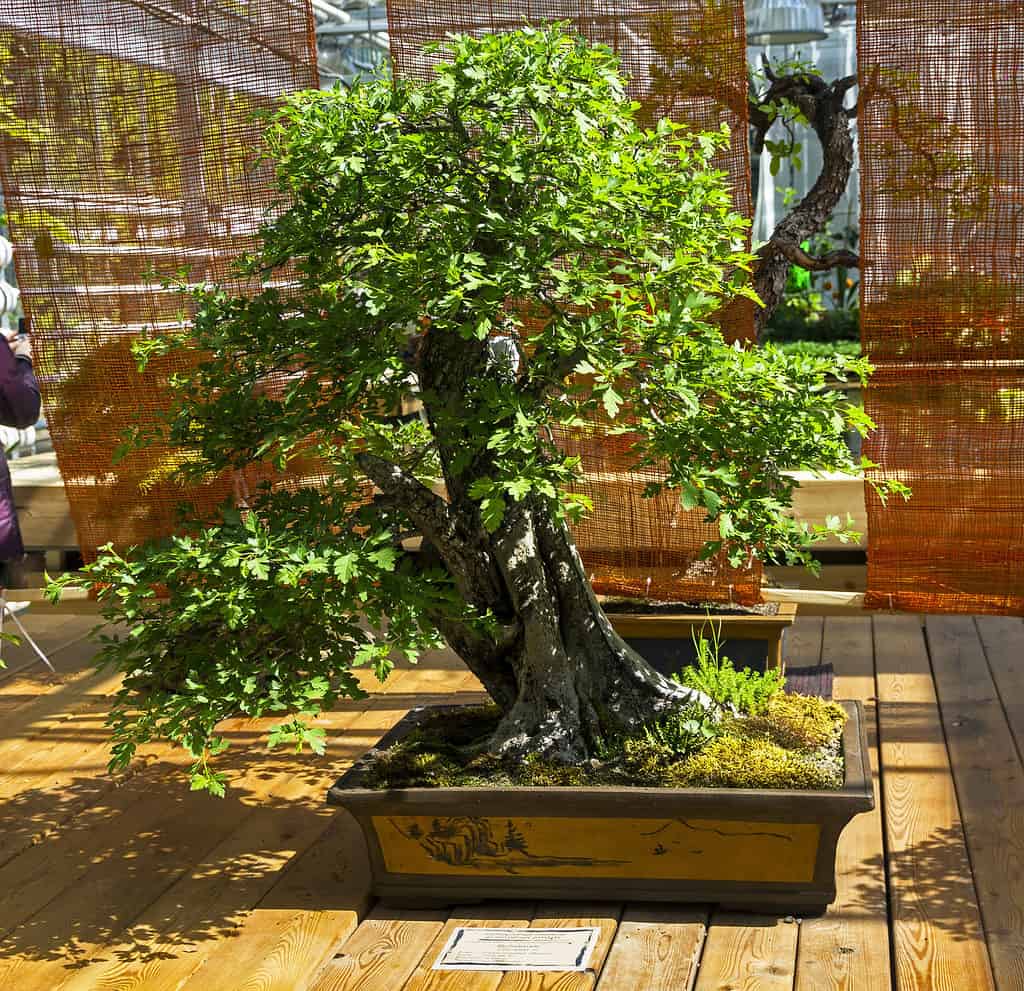
The flowers and berries found on hawthorn Bonsai trees make them unique specimens.
©Sergey Rybin/Shutterstock.com
| Hawthorn Bonsai Tree Facts | |
|---|---|
| Botanical Name | Crataegus |
| Common Types | Crataegus cuneata, Crataegus phaenopyrum, Crataegus monogyna, Crataegus marshallii, Crataegus laevigata, Rhaphiolepis indica |
| Sunlight | Partial shade to full sun |
| Soil | Organic Bonsai tree potting mix; additional rocks or clay as needed |
| Water | Maintain moisture daily; too little water will cause leaves to dry out |
| For Beginners? | Intermediate; healthy specimens can be difficult to find and branches can get brittle with age |
| Indoors or Outdoors? | Outdoors only, with some root protection |
| Pairs Well With… | Seasonal decor, rocky outcroppings, and a shape that highlights how this tree changes throughout the year! |
Common Types of Hawthorn Bonsai Trees
There are hundreds of hawthorn shrubs and trees found around the world. Choosing a hawthorn specimen based on your location and climate is a good place to start. Keep in mind that hawthorn Bonsai trees grow best outdoors, so mimicking the natural environment preferred by certain species is a good method for choosing your next tree. with this in mind, here are some of the most common types of hawthorn plants used for Bonsai tree cultivation.
Common Hawthorn
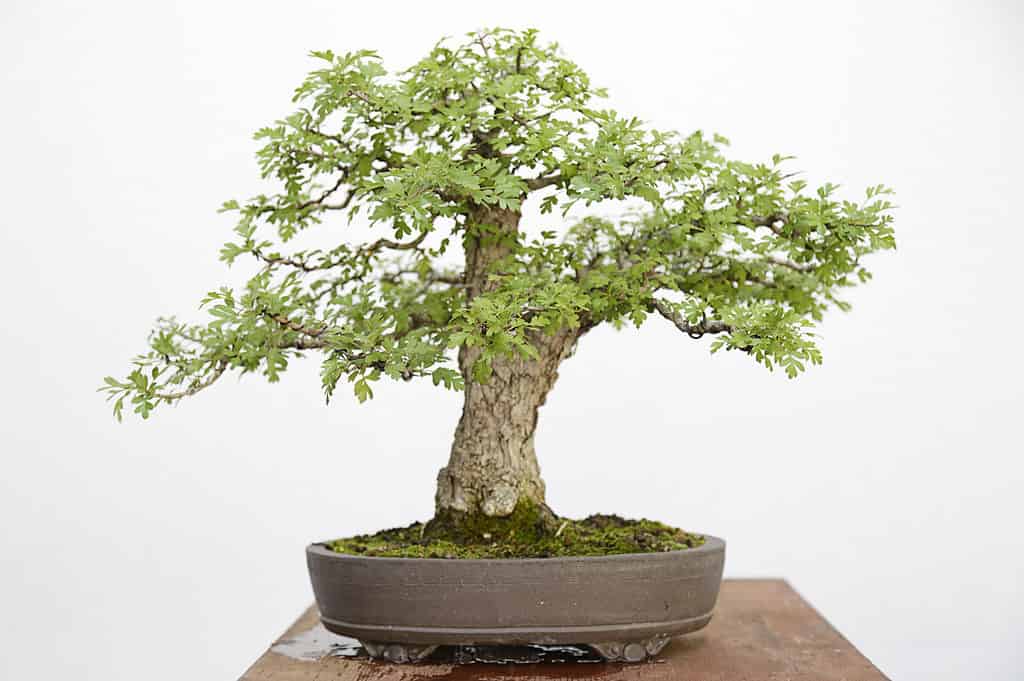
While occasionally difficult to work with, the common hawthorn makes a pretty Bonsai tree.
©Raquel Pedrosa/Shutterstock.com
With a name like common hawthorn, it should be no secret that this particular hawthorn tree is one of the primary species used in Bonsai tree cultivation. With a distinctly upright growth habit, common hawthorn Bonsai trees are often left to their own devices. You can shape a common hawthorn’s young branches fairly easily, but older branches grow brittle with time!
Japanese Hawthorn

Depending on the species, some hawthorn Bonsai trees produce pink or white flowers.
©Walter Pall/Shutterstock.com
Also known as the Chinese hawthorn, Japanese hawthorn trees are prized for Bonsai tree cultivation. They produce berries in either red or orange shades and their foliage is delicately lobed. Native to China, Japanese hawthorn trees are widely cultivated throughout Asia, thriving in Zones 6 or above.
English Hawthorn
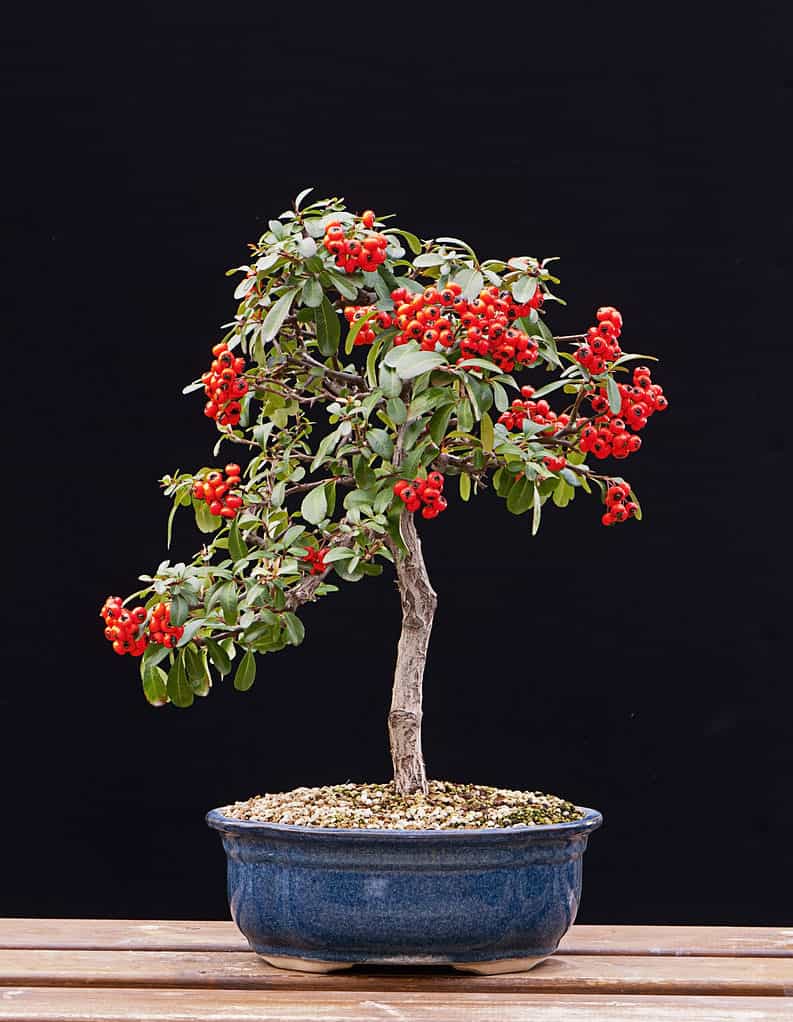
Your hawthorn Bonsai tree prefers to be kept outdoors.
©J.Blanco/Shutterstock.com
Native to Europe and also referred to as the midland hawthorn, English hawthorn trees make great Bonsai trees. There are a few different cultivars associated with this species, some of which produce reddish leaves. This is one of the more popular species for Bonsai tree cultivation, especially given the fact that it is resistant to drought and wind chill.
Parsley Hawthorn

The parsley hawthorn Bonsai tree grows well in the southeast United States.
©Walter Pall/Shutterstock.com
Also known as the parsley-leafed hawthorn, parsley hawthorn trees are hardy down to Zone 4. This hawthorn variety is also heat-tolerant in certain regions, making it a fairly easy Bonsai tree to care for outdoors. Plus, these hawthorn varieties occasionally produce branches without thorns, making pruning and shaping easier.
Washington Hawthorn
With bright red berries in the fall that grow in attractive clusters, the Washington hawthorn makes a lovely Bonsai tree. It is cold-hardy in Zones 5-9 and is fairly disease resistant. While it will still need protection from winter weather, it likely won’t give you as many problems in terms of pests!
Indian Hawthorn
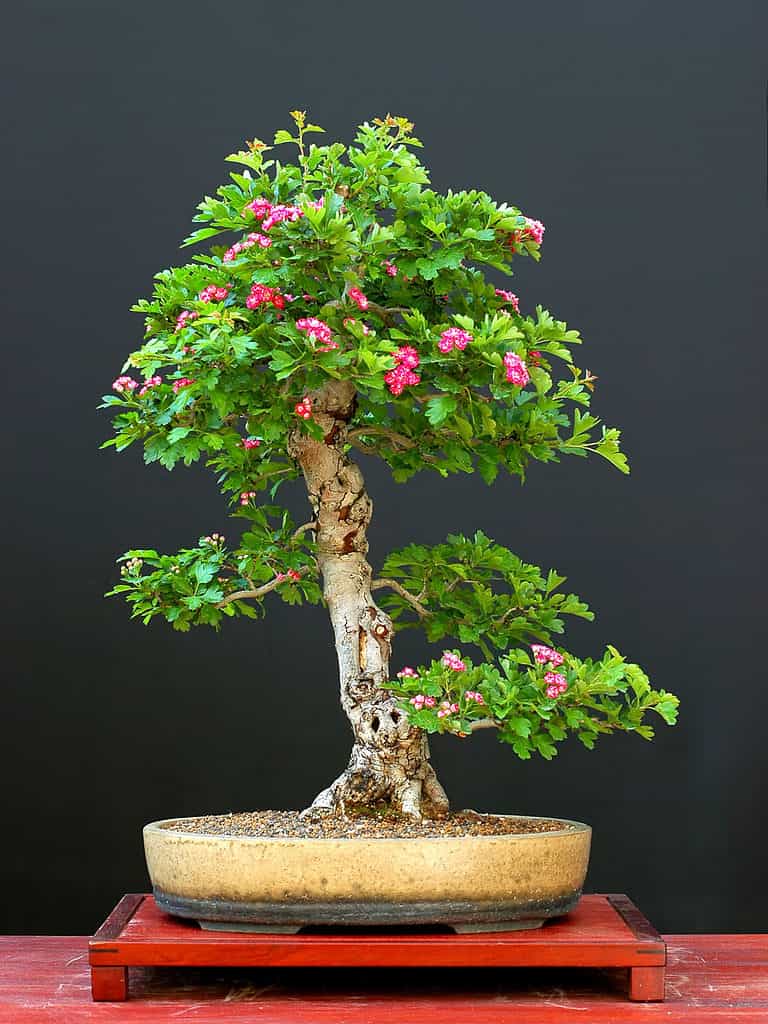
Some hawthorn Bonsai tree species produce flowers under the right circumstances.
©Walter Pall/Shutterstock.com
Technically a member of the closely-related Rhaphiollepis genus, Indian hawthorn is a shrub that is easy to prune and care for. This makes it an ideal Bonsai tree specimen, especially when you consider the fact that it will hold a rounded, pruned shape. However, Indian hawthorn isn’t particularly cold-tolerant, so be sure to protect it well during the wintertime.
Caring for Your Hawthorn Bonsai Tree
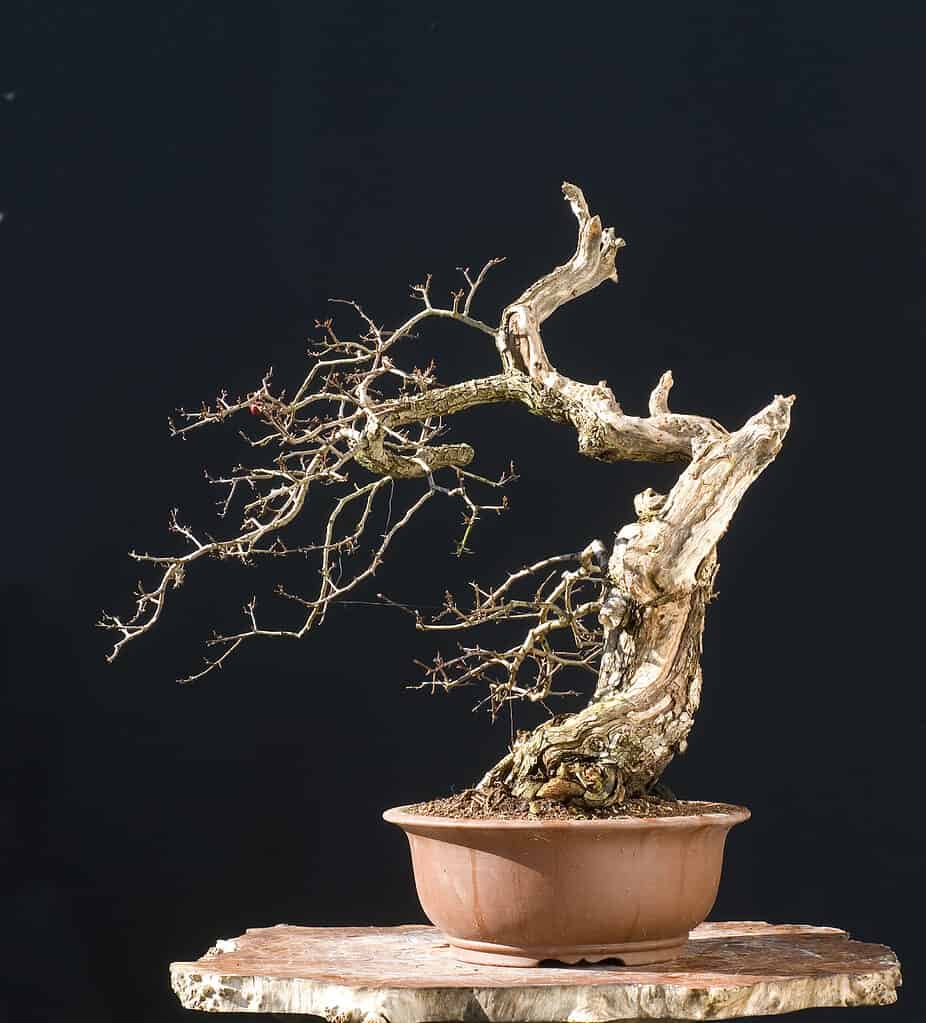
The naturally twisting branches of most hawthorn plants make them ideal Bonsai tree specimens.
©Walter Pall/Shutterstock.com
If you want your hawthorn Bonsai tree to thrive throughout all four seasons, you may want to consider investing in a fertilizer that promotes fruit and flower growth. However, you should make sure that it is gentle enough to not harm your delicate Bonsai tree, as their shallow root systems are highly susceptible to too much interference.
With all this in mind, hawthorn plants are fairly easy to care for in the grand scheme of Bonsai tree maintenance. These are incredibly hardy trees and shrubs in their natural environments, making them fairly resistant to changing temperatures and certain weather conditions. However, this intermediate Bonsai tree can be finicky depending on the way it is pruned. Let’s take a closer look at how to care for a hawthorn Bonsai tree.
Sunlight
Depending on the species, you can grow your hawthorn Bonsai tree in full sun to partial shade conditions. It’s best to choose a location and stick with it, given the fact that most Bonsai trees do not like being moved frequently. Hawthorn plants are fairly resistant to wind, but make sure this location receives enough sunlight as well as some protection from harsh weather conditions.
Soil Type
While well-draining soil is a must, most hawthorn plants are not very picky about their soil types. A balanced pH level is a good place to start, with added organic material to support flower and fruit growth. You may also want to add more lava rocks or pumice stones to your Bonsai soil mixture, as hawthorn plants do well in rocky soil.
Water
You never want to leave your Bonsai tree specimen sitting in water or at risk of over-watering. However, hawthorn plants prefer to be kept consistently moist throughout the day. This can be a difficult balance to achieve, but the foliage of your hawthorn plant will begin to dry out if it isn’t receiving enough water. So long as you pay close attention, you’ll likely figure out a watering routine in no time!
Placement
As previously discussed, your hawthorn Bonsai tree will do well in either direct light or partial shade conditions outdoors. Even though it will need winter protection, your hawthorn plant should be kept outside year-round. This is the only way to encourage your hawthorn Bonsai tree to flower and fruit according to the seasons. However, placing it in a location away from wildlife may be helpful, as songbirds are very attracted to the fruits produced by hawthorn plants!
Pruning Your Hawthorn Bonsai Tree

Keep in mind that the majority of hawthorn plants produce thorns, something you may want to remove before shaping.
©qSPOoKYp/Shutterstock.com
When it comes to pruning and shaping your hawthorn Bonsai tree, paying attention to the seasons is key. During the spring and summertime, fertilizing and pruning are recommended. This is when the tree is healthiest and capable of bouncing back from any harm, though any intense cutting or pruning will need a year or more to heal. Plus, make sure to prune in different locations rather than the same one over and over, as this will permanently scar your tree.
In the wintertime, you should wire your hawthorn tree and help shape it. All of the foliage should be gone from your specimen at this point in time, making it easy to see the branches you are working with. Keep in mind that the majority of hawthorn plants produce thorns, something you may want to remove before shaping. Some artists choose to leave thorns on their hawthorn Bonsai trees, as this is more of an homage to the plant growing in its natural habitat!
Recommended Hawthorn Bonsai Tree Styles
With care and patience as well as proper timing, you can shape your hawthorn Bonsai tree into just about any style. Many Bonsai tree artists prefer to structure their Hawthorn trees in a natural or wild way, such as the windswept style or the multi-trunked look. Choosing pot ornamentation based on the seasons is also fun. Create a beautiful fall landscape as your hawthorn leaves turn yellow, or perhaps fill in your pot with wintery accents as your tree grows bare!
No matter what you choose, keep in mind that most older hawthorn branches get brittle and more difficult to shape as they age. They need extra time and care or these branches will snap. This is the primary reason why hawthorn Bonsai trees may not be the best match for beginners.
Propagating Your Hawthorn Bonsai Tree
You can grow a hawthorn Bonsai tree from seed or from cuttings taken from existing plants. While growing from seed takes far more time than growing a tree from a cutting, this may be your best bet at producing a healthy specimen. Many hawthorn bushes and trees don’t make ideal propagation candidates due to their age or potential diseases.
However, if you know of a healthy specimen to take a cutting from, you should take this cutting in the summertime. Remove 5 inches or less from the plant and add it to your soil. The cutting should still have some flexibility in it, but the branch shouldn’t be so new that it is primarily green in appearance. As with any hawthorn plant maintenance, watch out for thorns!
Common Problems with Hawthorn Bonsai Trees

Taking care of a hawthorn Bonsai tree can be particularly rewarding, especially when given the opportunity to view it year-round.
©Goodly Pixels/Shutterstock.com
While hawthorn plants are fairly hardy specimens to work with, a number of pests and diseases can still plague them. This is especially true given the fact that they are grown outside. You may want to purchase a specialized insecticide or other products to help combat these issues. Some of the most common problems and pests associated with hawthorn Bonsai trees include:
- Aphids
- Various types of mites
- Fire blight
- Caterpillars
- Various fungal infections
- Weevils
- Scale
- Rust diseases
Taking care of a hawthorn Bonsai tree can be particularly rewarding, especially when given the opportunity to view it year-round. This unique Bonsai tree can be lush and full of foliage one season, with another season producing flowers and berries. If you are worried about your skill level for this particular tree, give it a try and see how it goes. The average hawthorn plant is much more forgiving than other types of Bonsai tree species, so it’s worth it to try and care for this seasonal beauty!
The photo featured at the top of this post is © Raquel Pedrosa/Shutterstock.com
Thank you for reading! Have some feedback for us? Contact the AZ Animals editorial team.






